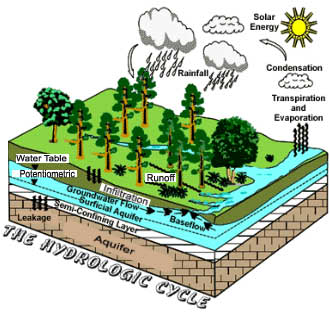|
The hydrologic cycle is a series of movements of water above,
on, and below the Earth's surface. It consists of four distinct
stages: storage, evaporation, precipitation, and runoff.
Waters of Earth continuously move from the oceans to the air,
to the land, and back to the oceans. The sun's heat evaporates
water from the oceans, which rises as an invisible vapor. The
vapor falls back to Earth in some form of precipitation. Most
precipitation drops back directly into the oceans; the remainder
falls on the rest of Earth, which eventually returns to the sea.
Due to nature's water cycle, there is as much water on Earth today
as there ever was or ever will be. To give a more technically detailed
statistic, that should be changed to:
Very little water has been created or lost over the time period
from the beginning of time until now.
Almost all of the water on Earth has passed through the water cycle countless
times. Water may be stored temporarily in the ground, in oceans, lakes, and rivers,
and in ice caps and glaciers. It evaporates from the Earth's surface, condenses
in clouds, falls back to the Earth as precipitation, and eventually runs into
the seas or re-evaporates into the atmosphere.
|

|

